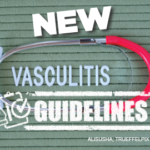On the other hand, for a patient who’s had the disease for five years, is stable and off glucocorticoids and doing well, you may want to image once a year or even every other year, depending, again, on which vessels are involved. Of course, if you have a patient who’s had critical coronary or carotid involvement, you may want to image them earlier, even if they’re stable. We didn’t give any specific recommendations because, when we stuck with the methodology, there was really not a whole lot of information in the literature. We wanted recommendations to be more evidence based than expertise based.
Q: The guidelines conditionally recommend not escalating therapy for patients who have acute phase reactant elevation but are clinically quiescent. How would you feel if the inflammatory markers were high or if they remained elevated for a prolonged period of time? Would you think about modifying therapy in such cases?
Dr. Abril: That’s another question that concerns us clinicians all the time. Our discussion focused on how specific the inflammatory markers were for disease activity. In a patient who’s asymptomatic, this should trigger close, or closer, observation. You may consider imaging sooner to ensure the patient doesn’t have active disease that may require escalation of therapy.
This recommendation mainly exists to remind clinicians not to start or increase immunosuppression just because the ESR is elevated. That said, of course, acute phase reactant elevation should raise a red flag, and if the patient has already had severe disease with significant organ involvement, you may not want to risk a serious episode, so the patient’s history will help you decide what to do as well.
Q: Could you talk about the data behind the series of recommendations that pertain to surgical management, and maybe even the instances when you think surgical intervention would be indicated? I think all of us are hesitant to intervene on an inflamed vessel, and medical management or surgical intervention was recommended for ongoing claudication and asymptomatic cervical disease. But the guidelines also favor escalating medical management for worsening limb organ ischemia and for renal vascular hypertension, and I could see that being a little bit more controversial.
Dr. Abril: When you look at the interventional trials that were included in the guideline, they only include patients who have failed medical therapy. Very few studies have been done in patients who were not treated with medical therapy first. Because of that, we recommended medical therapy prior to surgical intervention. A lot of patients experiencing critical stenosis may improve with medical therapy alone.


